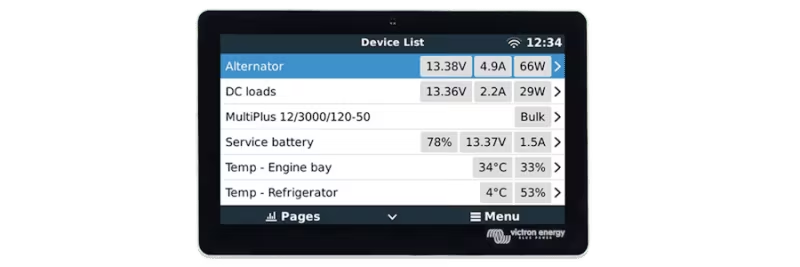Varukorg
Rabatt: 0,00 EUR
Rabatt: 0,00 EUR
Matthijs Vader, Victron Energy |31/01, 2022

Uppdatering 2022-02-16: Venus OS v2.81 till v2.84 har släppts. Dessa versioner innehåller främst buggfixar relaterade till v2.80 – inga nya funktioner. Vi rekommenderar att uppdatera till v2.84. Se hela ändringsloggen på Victron Professional.
Korrigering 2022-02-16: Bluetooth-radio i Cerbo GX är inte tillräckligt stabil för att fungera med Ruuvi-sensorer. Vid installation av Ruuvi-sensorer rekommenderas en Bluetooth USB-adapter. Mer information längre ned.
Venus OS är mjukvaran som körs på Cerbo GX, samt tidigare modeller som Color Control GX och Venus GX. Den finns även i GX-versionerna av MultiPlus-II och EasySolar-II.
Version 2.80 är en stor uppdatering med nya funktioner och förbättringar:
Ruuvi-sensorerna är batteridrivna och enkla att installera. Perfekt för att övervaka temperatur och luftfuktighet i båt, husbil, kyl eller frys. För att läsa data krävs en Bluetooth USB-adapter. Lista över kompatibla adaptrar finns på Victron Community.

Nu kan reläer på GX-enheten styras av temperatur, exempelvis för att starta en fläkt vid hög värme. Två separata villkor kan konfigureras per relä.

Med SmartShunt eller BMV-712 kan du nu mäta DC-laster exakt, t.ex. generatorutgång eller separata kretsar. Detta förbättrar laddningskontroll och systemoptimering.
Stöd för AC-mätare (Carlo Gavazzi) för att mäta laster eller kretsar med flera laster. Ny roll: AC Load Monitor.
Mer detaljerad information om generatorstatus, AC-ingång och AC-laster i VRM-portalen.
Stöd för visning av ström och effekt på andra fasen för nordamerikanska marknaden.
Lås-knapp för att undvika oavsiktliga knapptryckningar, fler språk och buggfixar.
Fullt stöd för Inverter RS inklusive DVCC och SOC-synk. Multi RS får preliminärt stöd.
Symmetrisk effektfördelning över alla faser för bättre effektivitet.
Automatisk aktivering för Pylontech, BMZ och Lynx Smart BMS. Färre konfigurationsfel.
Se hela ändringsloggen på Victron Professional. Instruktioner för firmwareuppdatering finns i manualen för din GX-enhet.
Rekommendation: Uppdatera till Venus OS v2.84 för bästa stabilitet och funktionalitet.